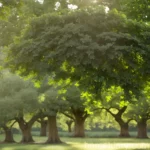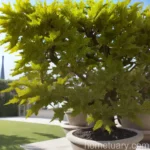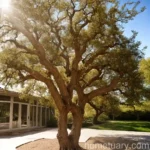The Willow Oak (Quercus phellos)
The Willow Oak (Quercus phellos) is a stunning tree species known for its graceful appearance, valuable timber, and habitat provision for wildlife. As a plant scientist, I am passionate about sharing knowledge and insights about this remarkable tree. In this comprehensive guide, we will delve into the characteristics, care requirements, uses, and fascinating aspects of the Willow Oak.
What is Quercus phellos?
Quercus phellos, commonly referred to as the Willow Oak, belongs to the red oak group within the genus Quercus. This deciduous tree is native to eastern and central North America and is a prominent feature of many landscapes due to its impressive stature and ornamental value.
Willow Oak (Quercus phellos) Key Takeaways
Before we delve into the specific aspects of the Willow Oak, let’s take a look at some key takeaways regarding this magnificent tree.
- Scientific Name: Quercus phellos
- Common Name: Willow Oak
- Species: Quercus phellos
- Family: Fagaceae
- Genus: Quercus
- Type: Deciduous Tree
- Native Range: Eastern and central North America
- Habitat: Prefers moist, well-drained soils in full sun
- Uses: Ornamental tree, valuable timber, wildlife habitat
- Distinct Feature: Graceful, slender leaves with a willow-like appearance
- Growth Rate: Moderate to fast
- Disease Resistance: Generally resistant to major diseases and pests
Now, let’s explore the various aspects of the Willow Oak in detail, ranging from its cultural requirements to its role in ecosystems and fascinating adaptations.
Culture
Understanding the cultural requirements of the Willow Oak is essential for ensuring its optimal growth and development in various settings. Here are the key cultural aspects to consider when cultivating Quercus phellos:
Water
- Young Trees: During the initial establishment phase, young Willow Oak trees require regular watering to support root development and overall growth.
- Mature Trees: Once established, the Willow Oak exhibits good drought tolerance. However, providing supplemental watering during prolonged dry spells can enhance its overall health and vigor.
Sunlight
- Full Sun: Willow Oaks thrive in full sun, requiring at least 6 to 8 hours of direct sunlight daily for robust growth and abundant leaf production.
Fertilizer
- Nutrient Requirements: While mature Willow Oaks are generally low-maintenance and can thrive in nutrient-poor soils, applying a balanced fertilizer in early spring can support healthy growth, particularly in urban or compacted soil conditions.
Soil
- Well-Drained Soil: Quercus phellos prefers moist, well-drained soils that are slightly acidic to slightly alkaline. It is important to avoid waterlogged or compacted soil conditions, as they can negatively impact the tree’s overall health.
Pruning
Proper pruning is essential for maintaining the structural integrity, aesthetics, and health of the Willow Oak. Here are some key considerations for pruning this species:
- Pruning Time: Late winter to early spring is the ideal time for pruning Willow Oaks to minimize sap loss and reduce the risk of disease transmission.
- Pruning Objectives: Pruning objectives may include removing dead or diseased branches, shaping the canopy, and promoting better air circulation within the tree’s crown.
Propagation
While Willow Oaks are most commonly propagated from seeds, there are other methods that can be employed for propagating this species:
- Seed Propagation: Collecting and germinating Willow Oak seeds can be a rewarding way to propagate this tree. It is important to stratify the seeds before sowing to improve germination rates.
- Vegetative Propagation: Propagating Willow Oaks through cuttings or grafting techniques can also be explored for specific cultivars or specialized propagation purposes.
Container Popularity
While Willow Oaks are primarily grown in landscapes and natural settings, they can also be cultivated in containers under the right conditions. Container-grown Willow Oaks offer the flexibility of incorporating these majestic trees into various urban and confined spaces.
Common Diseases
Though relatively resilient, Willow Oaks may encounter certain diseases that can impact their health and vigor. Understanding these common diseases and their symptoms is crucial for timely management and treatment. Some of the common diseases that affect Quercus phellos include:
- Oak Wilt: A fungal disease that can rapidly spread and lead to wilting and dieback of branches. Early detection and appropriate management are essential for preventing the spread of oak wilt within a stand of trees.
- Anthracnose: Fungal infections caused by various species of Colletotrichum can lead to leaf spot, defoliation, and twig dieback. Proper sanitation and appropriate fungicidal treatments are often recommended for managing anthracnose in Willow Oaks.
- Powdery Mildew: This fungal disease can present as white powdery growth on the leaves, negatively impacting the tree’s overall health and aesthetics. Pruning to improve air circulation and applying fungicidal treatments can help manage powdery mildew.
Disease Diagnosis
Recognizing the symptoms of diseases that affect Willow Oaks is instrumental in implementing effective disease management strategies. Here are some key diagnostic points for identifying common diseases:
Oak Wilt
- Symptoms: Rapid wilting and bronzing of leaves, often starting at the top of the tree and progressing downward. Dark streaks in the sapwood may also be visible upon bark removal.
- Diagnostic Tools: Consulting with a certified arborist or tree care professional for laboratory testing and analysis of symptomatic tissue can aid in confirming oak wilt.
Anthracnose
- Symptoms: Irregularly-shaped lesions on the leaves, often leading to defoliation and twig dieback during periods of high humidity and moisture.
- Leaf Inspection: Examining the leaves for characteristic lesions and patterns can help in diagnosing anthracnose in Willow Oaks.
Powdery Mildew
- Symptoms: White powdery growth on the upper surface of leaves, along with leaf distortion and reduced photosynthetic activity.
- Visual Examination: Observing the characteristic powdery growth on the leaves can aid in diagnosing powdery mildew in Willow Oaks.
Common Pests
While Willow Oaks are relatively resistant to major pest infestations, they can still be susceptible to certain pests. Understanding the common pests and their impact on the tree is vital for implementing appropriate pest management strategies. Some of the common pests that may affect Quercus phellos include:
- Gypsy Moth: Defoliation caused by gypsy moth caterpillars can weaken the tree over time, potentially making it more susceptible to other stressors and secondary pests.
- Scale Insects: Infestations of scale insects, such as the oak lecanium scale, can lead to reduced vigor and honeydew secretion, resulting in the growth of sooty mold on the leaves and branches.
- Twig Girdler: Adult twig girdler insects can cause damage by girdling and weakening branches, leading to twig dieback and reduced overall tree health.
Botanist’s Tips
As a plant scientist, I have gathered valuable insights and tips for cultivating and caring for the Willow Oak based on scientific knowledge and practical experience. Here are some essential botanist’s tips for successfully growing and nurturing Quercus phellos:
- Site Selection: When planting Willow Oaks, carefully select a site that provides well-drained soil, ample sunlight, and sufficient space for the tree to reach its mature size without interference.
- Root Zone Protection: Implementing measures to protect the root zone, such as mulching and avoiding soil compaction, is crucial for maintaining the long-term health and vitality of the Willow Oak.
- Integrated Pest Management: Incorporate integrated pest management practices, including regular monitoring, biological control, and targeted treatments, to effectively manage pests while minimizing the use of pesticides.
- Disease Prevention: Proactive measures such as promoting good air circulation, practicing regular sanitation, and selecting disease-resistant cultivars can contribute to the prevention of common diseases in Willow Oaks.
Fun Facts
Now, let’s explore some fascinating and lesser-known facts about the Willow Oak that highlight its unique characteristics and ecological significance:
- The leaves of the Willow Oak resemble those of willow trees, featuring narrow, lance-shaped forms, hence the common name “Willow Oak.”
- Quercus phellos is often planted as a street tree due to its upright, symmetrical growth habit and tolerance of urban conditions.
- Willow Oaks are known for their spectacular autumn foliage, turning various shades of yellow, bronze, and red, adding visual appeal to landscapes.
- The acorns of Willow Oaks serve as a valuable food source for a variety of wildlife, including squirrels, deer, and various bird species.
- The wood of the Willow Oak is highly prized for its strength and durability, making it an excellent choice for furniture, flooring, and construction purposes.
Links to External Resources
For further exploration and in-depth information about the Willow Oak, I recommend visiting the following external resources:
- The Morton Arboretum – Willow Oak
- USDA Forest Service – Quercus phellos
- Lady Bird Johnson Wildflower Center – Quercus phellos
In conclusion, the Willow Oak (Quercus phellos) stands as a charismatic and valuable tree species, contributing to the beauty of natural landscapes and urban environments alike. By understanding its cultural needs, identifying potential diseases and pests, and appreciating its unique attributes, we can cultivate, appreciate, and preserve the intrinsic value of the Willow Oak in our ecosystems.
I trust that this comprehensive guide has provided you with a deeper understanding of the Willow Oak and its significance in the world of plants and trees. Whether you are a gardener, landscape enthusiast, or nature lover, the Willow Oak undoubtedly holds a special place in the botanical tapestry of North America.















